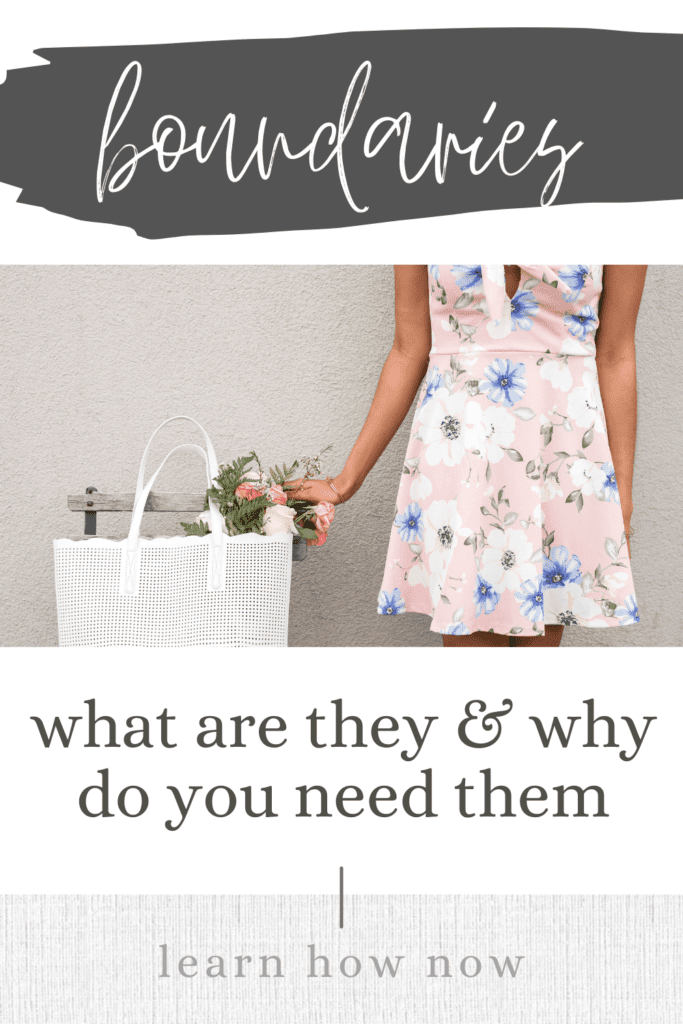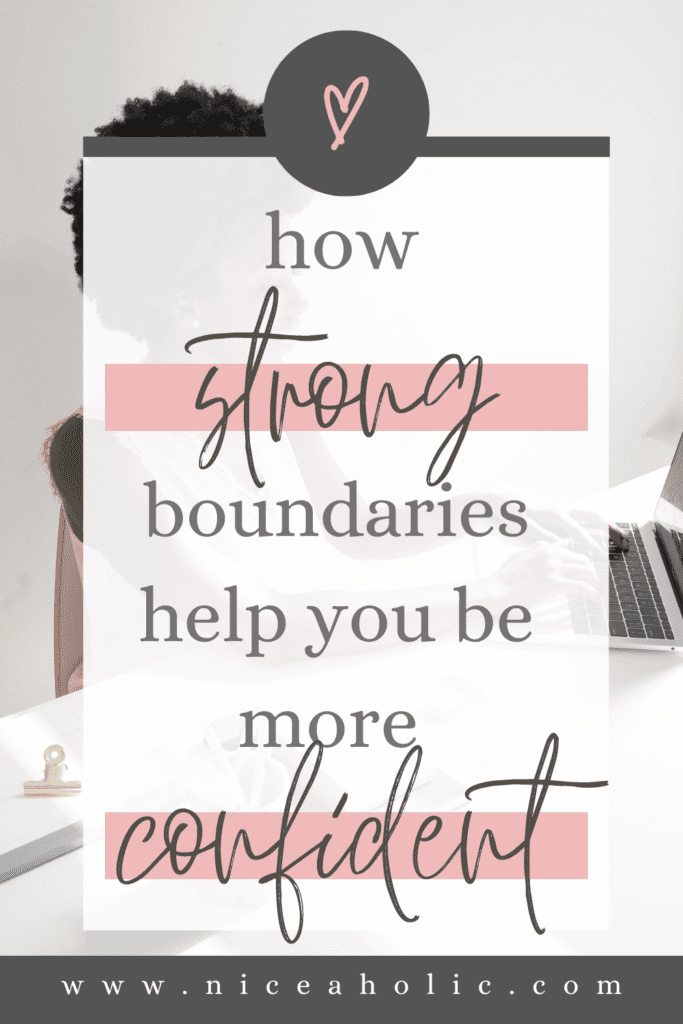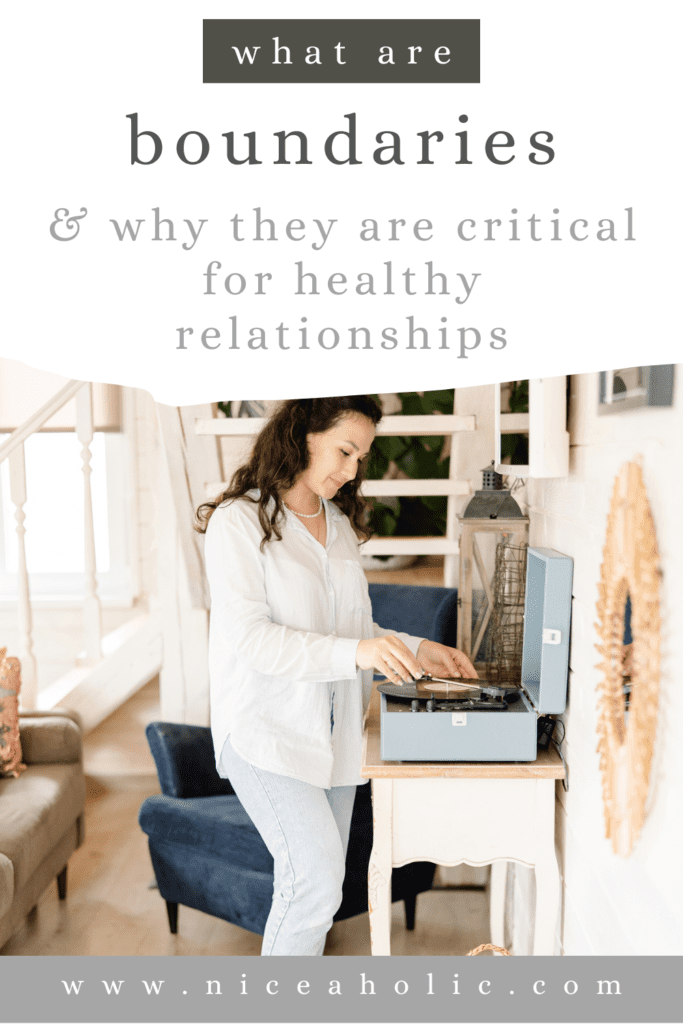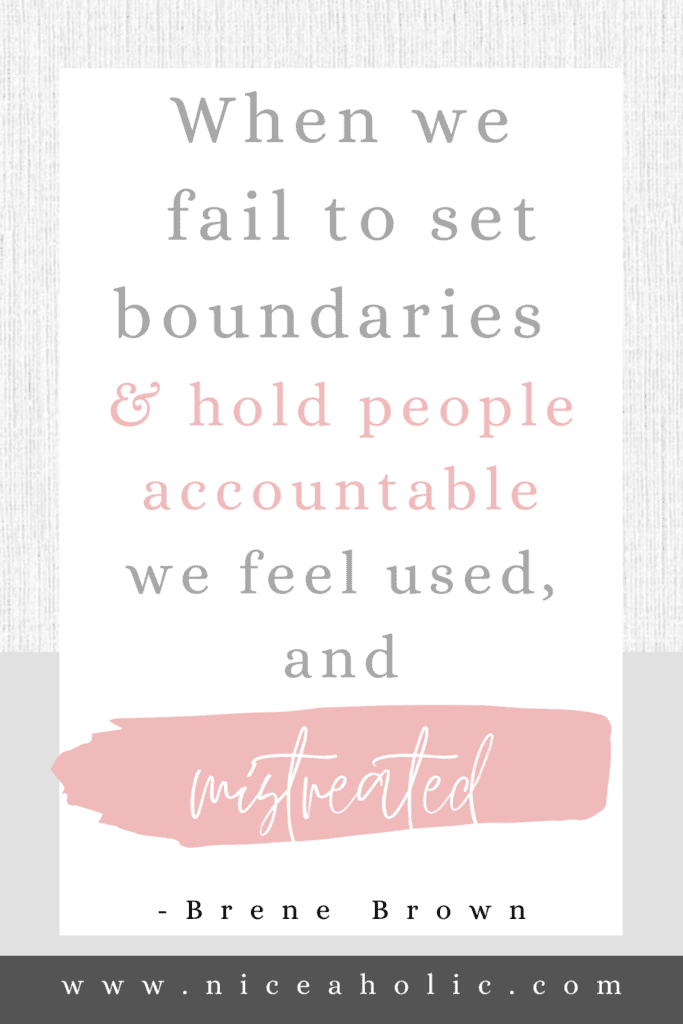What Are Boundaries and Why Do You Need Them?

Have you been wondering what are boundaries, and if they can help you?
As a niceaholic, you may struggle with the concept of boundaries.
So, if you’re new to understanding boundaries, you might have heard the term but not fully understood what it means or how it applies to you.
Boundaries are limits that you set to protect your mental and emotional well-being, and to establish a sense of autonomy in your relationships.
As a people-pleaser, it’s common to feel hesitant to speak up and assert your needs.
However, setting and communicating clear boundaries is essential to breaking the cycle of codependency and reclaiming your sense of self.
In fact, establishing boundaries can be a powerful act of self-care and self-love.
Today, you’re in luck because I’m going to guide you through everything you need to know about boundaries but were too afraid to ask.
We’ll cover what boundaries are, why they’re important, and how to start setting them in your life.
By learning to establish healthy boundaries, you’ll be better equipped to navigate your relationships and live a more fulfilling life.
What are Boundaries?
As a niceaholic, you may have trouble with setting boundaries and saying “no” to others.
That’s where boundaries come in – they’re guidelines for what is and isn’t acceptable behavior towards you.
In essence, boundaries are a set of rules that help you protect your own well-being and ensure that you’re not taken advantage of by others.
By setting clear boundaries, you can prioritize your own needs and cultivate healthier relationships with those around you.
These standards aim to help you build self-respect, establish your personal values, and prevent burnout.
They also give you a sense of control over your life and reduce stress levels.
Want to know how to set and maintain boundaries to your best advantage?
Download the Beautiful Boundaries Planner: A Nice Girl’s Guide to Setting Strong Boundaries for free today!
Download my
beautiful boundaries planner
Why are Boundaries Important for Niceaholics?
You may be a niceaholic, someone who struggles with codependency and people pleasing, and have heard that setting boundaries can be difficult and uncomfortable.
However, setting boundaries is crucial for your well-being and happiness.
Without boundaries, you may find yourself constantly overextended, feeling resentful, and experiencing burnout.
In fact, studies have shown that setting and enforcing healthy boundaries can lead to reduced stress levels and increased self-esteem.
By learning how to set boundaries, you’ll be able to prioritize your own needs and wants, which will ultimately lead to more fulfilling relationships and a happier, more authentic life.
So don’t be afraid to start setting boundaries today – you deserve to live a life that feels true to you.

On top of that, setting boundaries can help you manage your workload more effectively.
For example, when I started practicing setting boundaries, I found that I was able to take on fewer tasks and client projects without feeling guilty or overwhelmed.
By saying “no” to things that didn’t align with my priorities and values, I was able to focus on the tasks that were truly important and do them well.
This not only reduced my stress levels but also improved my productivity and allowed me to achieve better results.
Background of Boundaries
Don’t worry, this isn’t going to be a boring history lesson. Understanding the history of boundaries can help us comprehend the reasons for their existence and how they evolved over time to become the fundamental concept they are today.
Let’s take a trip back in time to ancient Greece, where philosophers such as Aristotle recognized the importance of defining personal limits and the need to respect others’ boundaries.
Fast forward to modern times, and boundaries have become a crucial part of our daily lives, as we navigate our relationships with friends, family, and colleagues.
As a recovering niceaholic, I struggled to say “no” and found myself taking on too much until I discovered the power of boundaries.
For example, I used to feel overwhelmed and guilty when I couldn’t be present for my daughter all the time.
However, when I started setting clear boundaries around my work hours and sticking to them, I found that I was able to be more focused and productive during those hours and be fully present with my child during my non-work hours.
I wasn’t as distracted and snappy and actually enjoyed my time with her. (She is such an amazing human!)
Setting boundaries not only helps you overcome common challenges, but it also allows you to better prioritize your time and energy.
This can lead to greater productivity, improved relationships, and overall well-being.
If you want to learn more about how to set and maintain healthy boundaries, I highly recommend checking out Brené Brown’s, TED talk on vulnerability.
You can find Brene’s talk here.
How Boundary Setting Works
So far, we’ve stayed pretty theoretical in our exploration of boundaries, and if you’re still a bit confused, I don’t blame you.
In fact, when I first started learning about boundaries, I felt like I was being selfish and mean to others.
Now I’m able to see boundaries as a form of self-care and a normal part of being an adult. It’s about looking after me and not hurting others. Now, I feel more confident in my relationships and am clearer on what I want, finally.
Luckily, implementing boundaries is more practical than it sounds in theory.
I’ve put together a few examples of boundary-setting below to help you better understand and see it applied in different situations.
Saying No
One of the biggest challenges most women face is saying no to requests that they can’t accommodate.
If you are a busy working mom, you can overcome this by setting clear boundaries and saying no without feeling guilty.
Learning to say no is a crucial skill that can help you avoid burnout and focus on what truly matters.
Here are three steps you can take to say no effectively:
Step 1: Be clear and honest about your priorities.
Before you say yes to any new request, take a moment to consider whether it aligns with your goals and values. If it doesn’t, it’s okay to say no. Be honest with the person making the request, and explain that you simply can’t commit to something that doesn’t fit with your priorities at this time.
Step 2: Offer an alternative solution.
If you’re saying no to a request that you would otherwise be interested in, consider offering an alternative solution that could still benefit both parties. For example, if someone asks you to lead a committee at your child’s school but you don’t have the time, you could suggest someone else who might be a good fit for the role.
Step 3: Practice saying no in a polite but firm way.
It can be uncomfortable to say no, especially if you’re used to saying yes to everything. However, it’s important to be clear and firm in your response.
How to Say No
Let’s look at an example of this in action:
If you are a busy working mom, you can often feel overwhelmed and pulled in too many directions.
Between your job, and your kids’ activities, you can struggle to keep up with everything.
If your child’s school asked you to take on a new leadership role in the PTA, you know you simply don’t have the time to commit to the position, but you feel guilty saying no.
If you try to make it work, squeezing in meetings and tasks whenever you can, you will find yourself increasingly stressed and exhausted.
You may end up missing deadlines at work and struggling to keep up with your kids’ schedules.
Instead, if you said no to the PTA position and explained that you simply couldn’t take on any additional responsibilities at this time, you could offer to help find someone else who might be a good fit for the role.
While it would be uncomfortable to say no, you would feel a sense of relief and empowerment knowing that you were taking control of your time and priorities.
Remember, every yes you give other people, is a no to yourself and your own priorities.
It will be hard at first, but once you learn that it is okay to prioritize your own needs, you will feel more in control and productive than ever before.
This means that you’ll have more time and energy to focus on what really matters in your life and career.
Want to learn how to set boundaries like a pro? Download my Beautiful Boundaries Planner and discover practical tools and strategies that you can apply right away.
Download my
beautiful boundaries planner
Healthy Relationships
Having healthy relationships requires setting clear boundaries and communicating your needs effectively.
Here’s how you can do it:
- Identify your values and priorities
- Communicate your boundaries assertively
- Enforce your boundaries consistently
Here’s how I applied these steps successfully:
Recently I was asked to return to the classroom and teach in person again, however I’ve been feeling quite anxious about instructing face to face and respectfully declined.
I offered to take the class online, but that didn’t work for them, and we parted ways.
Last week, they reached out and asked me to cover the class, as my replacement was away.
I was, again, asked to go in but I just couldn’t face it, and said no.
They knew the deal before they reached out to me, I also knew I had to enforce the boundary, or I’d end up back in the classroom, an anxious mess.
In the end they were happy to accommodate my request for teaching online, and they got someone to cover the class at short notice and I didn’t have to go in.
They respect my situation and are prepared to work with me, because I put my boundary down.
By implementing boundaries, you can create healthy relationships that support your personal and professional growth.
Built on respect, and not because you are the soft option who always says yes anymore.

Time Management
One of the most important things to understand about time management is that it’s not just about getting more done in less time.
It’s also about being more intentional with your time, prioritizing the things that matter most, and learning to say no to distractions and time-wasters.
Here are a few tips for getting started:
- Set clear goals and priorities for each day/week
- Use tools like calendars and timers to stay on track
- Learn to say “no” to requests that don’t align with your goals
Example: I’ve been getting a lot of freelance writing work lately and while I was excited at first and certainly relieved to have the extra money coming in, I have to be aware it is taking my time away from you and this blog.
I want to say yes to everyone because I’m a helper at heart, but I know if I do, I’m drifting away from my goals and creating a life that’s not aligned with my dreams.
Now I have enough work I must stop saying yes, otherwise I have no time to work on things that are important to me.
So, this is also a boundary I need to set with myself.
It wasn’t easy at first, but with practice, I will become more comfortable with politely declining more work.
Now I confidently delegate tasks that don’t fit within my priorities.
As a result, I can focus on what truly matters and be more productive with the time I have.
Saving myself a lot of stress in the process.
Emotional Intelligence
Emotional intelligence is the ability to recognize, understand, and manage our own emotions, as well as the emotions of others.
It’s a critical skill in both personal and professional settings, as it allows us to build stronger relationships, communicate more effectively, and make better decisions.
It’s important to boundary setting because you need a degree of self-awareness in order to pick up on situations where you are vulnerable to saying yes to something you shouldn’t.
Also to be able to see opportunities where you can place a boundary that will be most effective and have the greatest impact in your life.
Here are a few ways to develop your emotional intelligence:
- Practice active listening and empathy
- Learn to manage your own emotions in stressful situations
- Seek feedback and be open to constructive criticism
Let’s look at this in action:
You might have a tendency to react impulsively in high-stress situations, often making decisions you regret later. (Like saying yes, instead of no!)
If you practice emotional intelligence, you can learn to manage your own emotions more effectively.
Try taking a few deep breaths and counting to 10 before responding to challenging situations.
You could gather constructive criticism from those around you, to improve your emotional intelligence skills, or you can develop it yourself by using journaling and mindfulness.
Once you’ve developed the skill of emotional intelligence, you will be better able to communicate with your loved ones or workmates and make sound decisions even in high-pressure situations.
Remember, the key to mastering any new concept is practice and consistency.
By applying these examples to your own life, you can start to develop a deeper understanding of boundaries and the ways they can help you achieve your goals.

Conclusion – What are Boundaries?
I hope boundaries are crystal clear to you now.
I first launched Niceaholic because I really struggled with setting boundaries, and I could see the kind-hearted women around me did too.
This meant they were running around giving everything they had to other people, while forgetting to look after themselves.
Boundary setting is a powerful technique that helps you take back your power and live a more aligned life.
It can completely change your life, once you master it.
Do you still have questions?
No shame in that! You can contact me here or find me on social media, where I’m always happy to answer any questions.

One thing you can do to get started with boundary setting is download my free planner on Beautiful Boundaries below.


Beautiful boundaries
A nice girl’s guide to setting strong boundaries
Get your 13-page guide designed to help you build confidence and say no politely, yet firmly.
Free when you subscribe to my email list as my thank-you gift to you.





